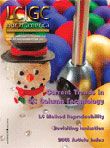Market Profile: Electronic Lab Notebooks
Laboratories use paper notebooks to document research, experiments and procedures, similar to that of a personal journal or, in some cases, a scrapbook. Laboratory notebooks are essential wherever scientific research is conducted, where data is collected, and where ideas that could be patented are developed. The lab notebook is often considered to be a legal document and can be used in court as evidence.
Laboratories use paper notebooks to document research, experiments and procedures, similar to that of a personal journal or, in some cases, a scrapbook. Laboratory notebooks are essential wherever scientific research is conducted, where data is collected, and where ideas that could be patented are developed. The lab notebook is often considered to be a legal document and can be used in court as evidence.
However, more R&D labs are abandoning the bound paper notebooks in favor of electronic laboratory notebooks (ELN), software programs that collect and organize data from unrelated sources into a single repository.

Electronic lab notebooks.
ELNs are new technology and offer many advantages. They allow easier collaboration among user groups, better recordkeeping, and can be made more secure than their paper counterparts. ELNs provide a means to secure intellectual property, while enabling access to common laboratory software and desktop applications.
The life science sector has been the early adopter of ELNs. ELNs have become an important tool for regulatory compliance and electronic recordkeeping. They are useful especially in large organizations, as ELNs are able to support enterprise-wide data warehousing, querying, and reporting for effective decision-making.
Despite these advantages, potential users of ELNs still have been reluctant to transition to a paperless laboratory. The direct cost of a system has become less of an issue as prices have dropped considerably. However, the indirect costs such as implementation, customization, and training have prolonged market resistance. Other issues include data security, speed, ease of use, system flexibility, and maintenance.
Nonetheless, ELN developers have introduced advanced systems that certainly have lowered these barriers. The ELN market is estimated at $80–90 million for 2006. The growth of the ELN has attracted many laboratory software/informatics companies into the market wanting to integrate them into their platforms. The market is expected to continue to grow at a rapid pace over the next few years as ELNs move into the mainstream. In fact, several biotech and pharmaceutical companies already have gone paperless — setting a standard that others can follow. Long-term growth of the technology is expected to be strong, especially as developers continue to release application-specific solutions.
The foregoing data was extracted and adapted from Instrument Business Outlook, an SDi publication, and SDi's Global Assessment Report, 9th Edition. For more information, contact Glenn Cudiamat, VP of Research Services, Strategic Directions International, Inc., 6242 Westchester Parkway, Suite 100, Los Angeles, CA 90045, (310) 641-4982, fax: (310) 641-8851, e-mail: cudiamat@strategic-directions.com
New Study Uses MSPE with GC–MS to Analyze PFCAs in Water
January 20th 2025Scientists from the China University of Sciences combined magnetic solid-phase extraction (MSPE) with gas chromatography–mass spectrometry (GC–MS) to analyze perfluoro carboxylic acids (PFCAs) in different water environments.
The Next Frontier for Mass Spectrometry: Maximizing Ion Utilization
January 20th 2025In this podcast, Daniel DeBord, CTO of MOBILion Systems, describes a new high resolution mass spectrometry approach that promises to increase speed and sensitivity in omics applications. MOBILion recently introduced the PAMAF mode of operation, which stands for parallel accumulation with mobility aligned fragmentation. It substantially increases the fraction of ion used for mass spectrometry analysis by replacing the functionality of the quadrupole with high resolution ion mobility. Listen to learn more about this exciting new development.
A Guide To Finding the Ideal Syringe and Needle
January 20th 2025Hamilton has produced a series of reference guides to assist science professionals in finding the best-suited products and configurations for their applications. The Syringe and Needle Reference Guide provides detailed information on Hamilton Company’s full portfolio of syringes and needles. Everything from cleaning and preventative maintenance to individual part numbers are available for review. It also includes selection charts to help you choose between syringe terminations like cemented needles and luer tips.
The Complexity of Oligonucleotide Separations
January 9th 2025Peter Pellegrinelli, Applications Specialist at Advanced Materials Technology (AMT) explains the complexity of oligonucleotide separations due to the unique chemical properties of these molecules. Issues such as varying length, sequence complexity, and hydrophilic-hydrophobic characteristics make efficient separations difficult. Separation scientists are addressing these challenges by modifying mobile phase compositions, using varying ion-pairing reagents, and exploring alternative separation modes like HILIC and ion-exchange chromatography. Due to these complexities, AMT has introduced the HALO® OLIGO column, which offers high-resolution, fast separations through its innovative Fused-Core® technology and high pH stability. Alongside explaining the new column, Peter looks to the future of these separations and what is next to come.
Oasis or Sand Dune? Isolation of Psychedelic Compounds
January 20th 2025Magic mushrooms, once taboo, have recently experienced a renaissance. This new awakening is partially due to new findings that indicate the effects of psilocybin, and its dephosphorylated cousin psilocin may produce long lasting results for patients who might be struggling with anxiety, depression, alcohol and drug abuse, and post-traumatic stress disorder. Hamilton Company has developed a methodology for the isolation and identification of 5 common psychedelic compounds used in the potential treatment of disease. The PRP-1 HPLC column resin remains stable in the harsh alkaline conditions ideal for better separations.
